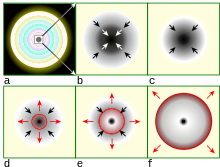Gravitational collapse
Gravitational collapse is a process where an object in space, like a star or cloud of gas, shrinks down because of its own very strong gravity. This gravity pulls everything closer to its center.
This plays a very important role in our universe. For example, you might have a cloud of things like stars or galaxies in space all over the place. But soon, gravity starts to bring everything together. This process forms all kinds of structures, like galaxy clusters, star clusters, stars, and even planets.[1]

For example, a star is born when a huge cloud of interstellar gas slowly comes together because of gravity. As this continues to happen, the pressure and temperature inside the cloud increases. Soon, the temperature and pressure becomes so much that they thermonuclear fusion starts.
When fusion starts, the star releases light and heat, and the energy it makes pushes outward, trying to stop gravity from crushing the star. This keeps the star stable.
But eventually, the star would run out of fuel and gravity will win. It will do another gravitational collapse and turn into something new. Depending on how heavy the star was, it could become a white dwarf, neutron star, or, if it was heavy enough, a black hole.
So, gravitational collapse is a fundamental process in the universe that help creates the structures we see, including the stars that light up our night sky.
References[change | change source]
- ↑ Eppelbaum, Lev Vilen; Eppelbaum, Lev; Kutasov, I. M.; Pilchin, Arkady (2013). Applied geothermics. Lecture notes in earth system sciences. Berlin: Springer. ISBN 978-3-642-34023-9.
